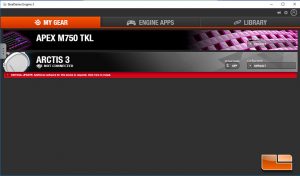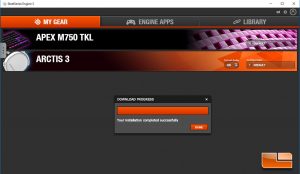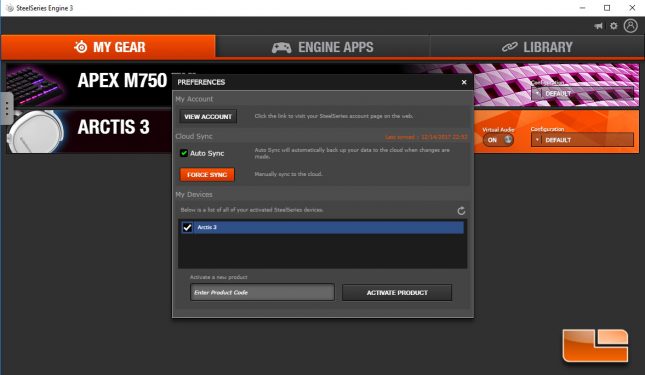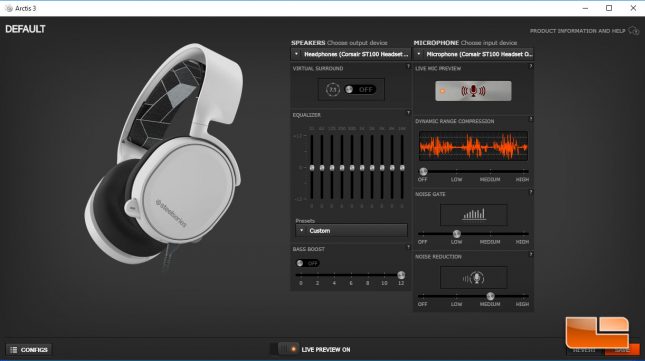SteelSeries Arctis 3 Gaming Headset Review
SteelSeries Arctis 3 Gaming Headset – Engine 3 Software and Testing
SteelSeries Engine 3 version 3.1.1.7 was used for testing of the Arctis 3. This version is available on the SteelSeries website and is the latest official release of the software. I’ve used this particular version for the past couple of SteelSeries products I have reviewed. To test the SteelSeries Arctis 3 headset, I used the Sound Blaster X Katana, which has a built-in 24-Bit DAC that operates over USB. I’ve found that the Katana mic input allows for clear, clean recording and have used it for my last few reviews to get recording samples. I also verified that the Engine 3 software interacted properly and allowed for virtual surround sound on the Aorus Z370 Gaming 5 Realtek onboard audio and Corsair ST100 RGB Headset Stand, as well. The Engine 3 software worked fine with all of the sound devices I attempted to use it with and toggling between different sound cards wasn’t an issue.
Upon initially registering the Arctis 3, additional audio control software had to be downloaded from SteelSeries. This download went particularly fast and was seamless, with Engine 3 starting up completely once the download was completed and the additional software had been automatically installed.
Since the Arctis 3 connects over a 3.5 mm connection, the SteelSeries Engine 3 software can’t actually tell if it is installed. In order to get around this, SteelSeries provided a registration code that unlocks the headset in their software, giving a layer that installs over the sound card, allowing the Arctis 3 to be used in Surround Mode with any sound card that has a 3.5 mm input.
Besides offering a 7.1 surround sound toggle, the SteelSeries Engine 3 software gives users an equalizer with several presets and a bass boost slider. In the microphone settings section, SteelSeries gives users a preview mode, along with settings for dynamic compression, noise gate and noise reduction. Dynamic compression reduces variances in volume when you speak, so there won’t be peaks and valleys in your voice. The noise gate setting mutes the mic when no audio is detected and you can manually adjust this to three levels, making it so that you have to speak up to activate the microphone, which may be helpful when you are playing with an open microphone in a noisier environment and don’t want background noise picked up. Noise reduction is an overall reduction of noise picked up by the mic, which may sacrifice detail. In general, the ClearCast microphone worked great with the default settings, but it is nice to have the extra settings provided by the Engine 3 should you need to use them in a noisier environment.
The added functionality provided by the SteelSeries Engine 3 software was excellent and really helps wake up the Arctis 3 and turn them into a finely tuned gaming headset. The Arctis 3 SteelSeries Engine 3 functionality is activated through software and registered to the logged in user, so the Engine 3 software can theoretically be used with any headset that uses a 3.5 mm input. It was fun taking my other gaming headsets like the HyperX Cloud and using them with the Engine 3 software to bring out some extra functionality that my sound cards weren’t capable of. While the Arctis 3’s virtual surround mode isn’t quite up to par with Dolby Surround or DTS-X provided by the higher end Arctis units, the Engine 3 software offers extended equalization modes that aren’t even present on the higher end Arctis headphones, so there are some interesting trade offs. SteelSeries continues to improve their Engine 3 software and I haven’t experienced any issues or crashes with it across the past four SteelSeries products I’ve reviewed.
Subjective Audio Quality Comments
I’ve generally found that stereo mode on gaming headsets gives me the best positional audio in most games, with the typical surround modes available doing a decent job of phasing the audio, but not providing excellent audio quality. In general, the surround mode on the Arctis 3 is passable, but still has the typical airy, spaced out sound that comes with surround sound headsets. However, the positional audio in stereo mode on the Arctis 3 is great and I am able to tell where action is coming from, though a little more audio separation would have helped in that department. Basically, for the best experience with the Arctis 3 stick with stereo mode for most scenarios and toggle on surround when you find it applicable. Battlefield 1 and PUBG both sounded excellent on the Arctis 3 and I had no trouble telling where footsteps or gunfire were coming from, though a little more audio separation would have been bliss.
For listening to music, the Arctis 3 are passable, but since they tend to lack dynamic range and offer a more flat, neutral sound, they aren’t going to offer the best experience. Still, they were enjoyable to listen to electronic music on and certainly won’t turn users away based on how they sound. Most audiophiles will recognize the Arctis 3 sound as passable, but lacking range and not sounding completely natural. Compared to many gaming headsets, the Arctis 3 are great for listening to music, just don’t expect them to be on the level with some mid-level Sennheiser or Audio Technica cans.
Movies sound good on the Arctis 3, with vocalization coming through clearly and audio properly represented, without any over-boosting of frequencies or dynamic issues. I used Star Wars: The Force Awakens to test the Arctis 3 with an action movie encoded in surround. Surround mode was airy and spaced out, giving a less immersive feeling when watching content, so I just left the headset on stereo mode and tried equalizer settings, which gave better results. The Arctis 3 are definitely passable to watch movies on, but their relatively flat sound takes a bit of the punch and excitement out of the film. Still, the audio of Star Wars: The Force Awakens was reproduced well in stereo mode on the Arctis 3 and I could hear little details like individual laser blasts and BB8 scuttling along with great detail.
Microphone Recording Quality Comparison
I tested the microphone recording quality on the Arctis 3 over the Sound Blaster X Katana, which has a built in DAC that operates over USB. The recording was done at 44.1 KHz in Audacity at 90% recording levels for both microphones, with each microphone placed about three fingers width from my mouth at the proper, recommended angles. I tested the microphone on the Arctis 3 against the HyperX Cloud Alpha, a $99 LegitReviews Editors’ Choice Winner that I consider to be the standard-bearer for wired gaming headsets.
The ClearCast microphone on the SteelSeries Arctis 3 has clear pick up, though it isn’t as dynamic as I would like. Compared to many of the gaming headsets out there, the Arctis 3 sports a quality microphone that picks up my voice clearly and consistently. I think that the microphone on the Arctis 3 favors well against the mics on most gaming headsets, though there are certainly headsets with better, more dynamic microphones. One issue I have to note, that I won’t exhibit due to how annoying it would be, is that the ClearCast microphone suffers from bad pick-up of any cable-noise. So, if you you need to move the mic at all and your headset isn’t muted, you’re going to pass a lot of static and noise on to whoever you are chatting with. Just try to remember this and mute the mic on the Arctis 3 before you do any moving of it, or you might make people upset.
I do find that the HyperX Cloud Alpha and Arctis 3 microphones are very comparable, but that the HyperX has more dynamic range and a bit more fullness to it, bringing out more of my true voice and inflection. The HyperX Cloud Alpha microphone is one of the better microphones I have tested to date on a gaming headset and I do give it the slight edge over the SteelSeries offering, as it also doesn’t suffer from pick up on the cable and is removable and replaceable, something that the SteelSeries Arctis 3 can’t claim.
Here, we get a comparison against the standalone ModMic 5, a $69.95 standalone unit. While the recording quality is best and clearest on the ModMic 5 out of the three tested microphones, I think it paints the ClearCast microphone of the Arctis 3 in a good light. The Arctis 3 retail for just $10 more than the ModMic 5 costs, alone. Sure, the ModMic 5 sounds the fullest and has the best range, but for online games and Skype calls, which often compress recording quality anyways, the Arctis 3 is beyond acceptable. Now, if you’re trying to roll your own headset with a quality Sennheiser, Audio Technica, or Grado headphone, the ModMic 5 makes sense. For a gaming headset, the ClearCast mic on the Arctis 3 is damn fine.
Overall Thoughts on Sound and Mic Quality
Overall, the Arctis 3 have a clean, clear audio that is well-defined, but lacking in dynamics and separation. For gaming, the headset works well, with directional audio being precise in FPS games like Overwatch, though the surround mode generally made the audio looser and less precise, so I stuck with stereo mode. For music and movies, the Arctis 3 are passable, but they lack the dynamics and purity you’d find with a true audiophile headset. The S1 speaker drivers are good, better than the drivers you find in headsets from competition like Razer, but they aren’t quite up to par with the sound quality of the HyperX Cloud Alpha. The ClearCast microphone quality is top notch for a gaming headset, though not as dynamic or clear as the ModMic 5, which is understandable.
Let’s wrap up this review with my overall thoughts on the Arctis 3 as a complete package and see where it stands in the competitive gaming headset market.





